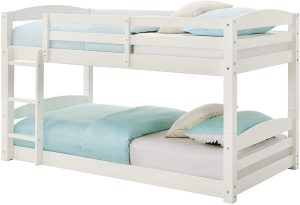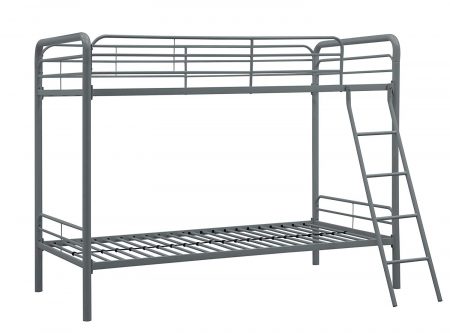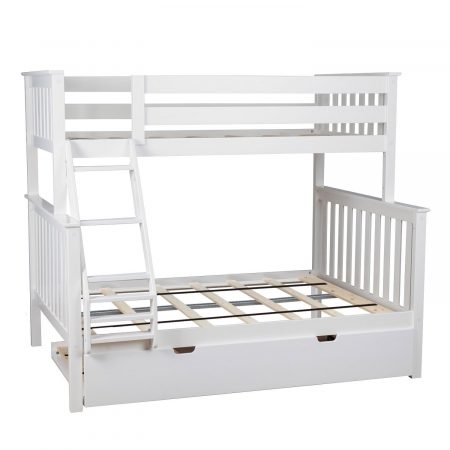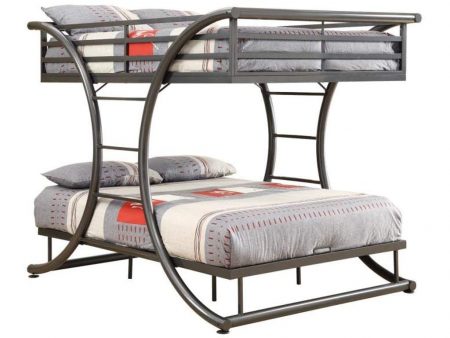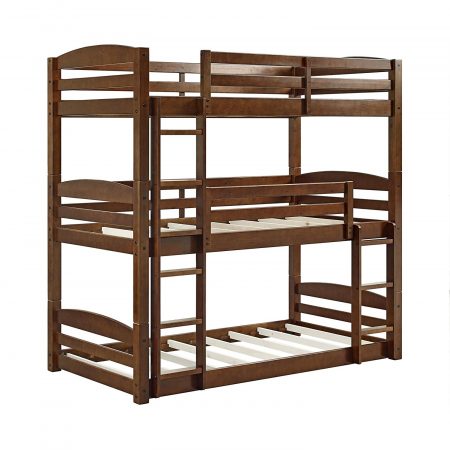Considerations for Bunk Bed Shoppers
When shopping for a new bunk bed and comparing different brands and models, here are a few important factors to keep in mind:
- Price: Bunk bed shoppers on a budget can find models for less than $300, but they should expect to spend at least $300 to $900 for a new bunk bed. Some high-end models cost upward of $3,000 to $5,000.
- Dimensions: Parents should measure the length, width, and ceiling height of the room where they plan to install a bunk bed before they begin browsing for models. This will ensure that the bunk bed they select will fit.
- Weight capacity: The weight capacity for the top bunk will be significantly lower than the weight capacity of the bottom bunk. A metal bunk bed, for instance, can typically support up to 200 pounds on top and up to 500 pounds on the bottom. Although this won’t be an issue for most small children, bunk bed weight capacity is more crucial for teenagers who share a bunk bed — particularly if one is significantly larger than the other. Remember: weight capacity refers to both the sleeper and the mattress, so lighter mattress types (such as memory foam and some innerspring models) are more suitable for bunk beds than heavier ones (such as latex, hybrid, or airbed models).
- Storage: Those with greater storage needs may prefer a loft bed, or a bunk bed bodel with a large amount of drawer space. Those with minimal storage needs have more options.
- Assembly: Some manufacturers offer in-home assembly services for customers, but in many cases the owner will need to assemble the bunk bed without outside assistance.
- Decor: Although this is a purely aesthetic consideration, bunk bed shoppers may prefer models that blend in — and not clash — with the bedroom’s existing furniture and fixtures.
- Return policy: A sleep trial may be included with the purchase of a new bunk bed. Most sleep trials run at least 30 nights, and allow customers to return their bunk bed model for a full refund within that window period if they are not satisfied with the product. However, many bunk bed purchases do not include a sleep trial.
- Warranty: Manufacturer’s warranties for bunk beds typically run 30 days to one year, but some extend up to five years in length.
- Protection plans: In addition to or in place of a product warranty, some bunk bed sellers offer protection plans that cover accidental damages, such as stains, cuts and tears, punctures, dents, and water rings. These plans do not cover damages that occur due to owner abuse or neglect, or other exclusions listed in the product warranty. Protection plans may also include full repairs with or without a required deductible. Most plans are optional, and available in different coverage lengths at varying price rates.
- Certifications: Bunk beds should be certified for residential and/or commercial use, and meet all applicable CPSC guidelines. Virtually all bunk beds sold through brick-and-mortar and online brands and retailers meet this criteria, but shoppers should still check to ensure all certifications are valid.
Bunk Bed Building Tips
Some parents may wish to craft a bunk bed themselves using lumber or metal they acquire themselves, rather than purchasing a manufactured model for home assembly. These individuals are encouraged to follow this step-by-step process:
1.) Meticulously measure the room in which the bunk bed will be located. Take width, depth, and ceiling height into consideration, as well as the placement of lights, ceiling fans, windows, and other room fixtures that the bunk bed should not be near or against. Also think about storage needs.
2.) Create clear blueprints. Assembly guides for manufactured models may be a useful starting point.
3.) Make a comprehensive inventory of materials and implements that will be needed, including:
- Bed materials, such as lumber and/or metal.
- Tools that may be needed, including a drill or electric screwdriver, hammer, saw, level, and measuring tape.
- Small parts, such as screws, nails, angle brackets, and wood glue.
- Lay out all materials to make sure each part is accounted for, and that the building materials meet the required measurement specs.
- Construct the bed in a place where children and pets won’t interfere, such as a garage, or close off the room to potential intruders. This will lower the risk of injury.
4.) Begin assembling the bottom bunk bed. Once this portion is complete, move onto the top bunk(s). Utilize the level throughout this process to ensure the design is sturdy and even.
5.) If constructing the bed from wood, be sure to thoroughly sand all surfaces to lower the risk of cuts and other injuries from splinters.
6.) If planning to paint or stain the bed, make sure all floor surfaces beneath the bed are covered with cloth, tarp, or other protective materials to prevent spillage.
Safety Concerns and Current Standards for Bunk Beds
Bunk beds sold in the U.S. are regulated under the U.S. Consumer Product Safety Commission (CPSC). Manufacturers and importers of children’s bunk beds must submit bunk beds to a CPSC-accepted, third-party laboratory for safety testing, and then obtain a Child’s Product Certificate that certifies the bed complies with all current safety standards and regulations. Those who manufacture or import adult bunk beds must likewise obtain a General Product Certificate after the required testing has concluded.
The CPSC’s current ‘bunk bed rule’ guidelines state the following:
Guardrails:
- “Bunk beds must have at least two upper bunk guardrails, with at least one rail on each side. Lower bunks with mattress foundations that are 30 inches or less from the floor do not have to have guardrails.
- The guardrail on the side of the bed next to a wall or on the side opposite to a ladder must run continuously from one end of the bed to the other. If the guardrail does not attach to an end of the bed, the gap between the end of the guardrail and the nearest end of the bunk bed cannot be greater than 0.22 inches.
- A guardrail on the side of the bed away from the wall does not have to run continuously from end to end of the bed, BUT the distance between either end of the guardrail and the end of the bed nearest to it cannot be greater than 15 inches.
- Guardrails must be attached to the bunk bed with fasteners that must be released before the rails can be removed, OR the rail or fastener must be designed to move in two or more different directions, one after the other, to release them.
- The tops of the guardrails must be no less than 5 inches above the top of the mattress.
- With no mattress on the upper bunk, any space between the bottom of the guardrail and the top of the mattress foundation must not let the wedge block pass through freely.”
Bunk Bed Ends:
- “No opening in either end of the upper bunk that is above the mattress foundation can let the wedge block pass through freely.
- When the thickest mattress and mattress foundation recommended by the manufacturer are used, the top of each end of the upper bunk must extend at least 5 inches above the top of the mattress, and that 5-inch margin of safety must extend at least half of the distance between the corner posts of each end.
- No opening in the headboard or footboard of the lower bunk below the mattress foundation of the upper bunk and above the mattress foundation of the lower bunk shall permit the wedge block to pass through freely – UNLESS the opening also allows a rigid 9-inch sphere to pass through it freely.
- Any opening in the headboard or footboard of the lower bunk below the mattress foundation of the upper bunk tested with the wedge block must also be tested for the risk of neck entrapment if the opening lets the 9-inch sphere pass through freely.”
The CPSC also provides guidance for testing bunk beds for entrapment hazards associated with the guardrails and both ends of the top and bottom bunks. In order to test for entrapment hazards, probing equipment is needed. A full equipment list and step-by-step procedures can be found in the CPSC Test Manual for Bunk Bed Entrapment Hazards.
For more information about bunk beds laws, please visit 16 CFR Part 1213, the federal regulation for adult bunk beds, and 16 CFR Part 1513, the federal regulation for children’s bunk beds.
In addition to these regulations, here are a few general safety guidelines for children’s bunk beds:
- Children aged five and under should not sleep on bunk beds. Most bunk bed injuries are related to falls involving children five and under.
- There should be absolutely no jumping or wrestling on the top or bottom bunks.
- Regardless of the listed weight capacity, no more than one person should ever sit on the top bunk.
- When using ladders or rungs to access the top bunk, children should keep at least three of their four hands and feet in place at all times, moving one hand or foot at any given time.
- Do not allow anyone to sleep on the top bunk if the guardrail is loose or partially detached.
- Do not allow children to hang or suspend themselves from the top bunk in any way. This could lead to fall-related injuries, and may also compromise the structural integrity of the bed.
- If a child has friend over for the night, be sure to inform that child’s parents of the bedding situation; some parents may object, in which case an alternate sleep surface will most likely be required.
- Bunk beds should never be placed directly beneath light fixtures or ceiling fans, nor should they be installed against windows.
- Parents should measure the space between the top bunk and ceiling to ensure there is enough room for sleepers on top without hitting the ceiling.
- Do not purchase used bunk beds. Buy new models or construct them using raw materials in order to ensure optimal durability and design.
